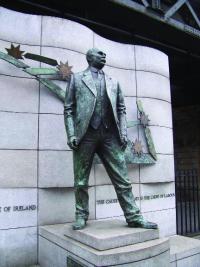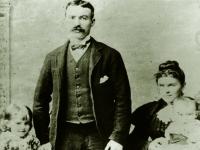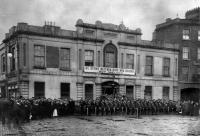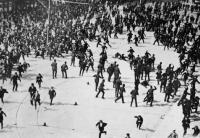Film eye:James Connolly: a working class hero Directed by Brian O’Flaherty, Bruno Dog Productions by Aindrias Ó Cathasaigh
Published in
1913,
20th Century Social Perspectives,
20th-century / Contemporary History,
Issue 6 (Nov/Dec 2010),
Reviews,
Revolutionary Period 1912-23,
Volume 18

The James Connolly monument in Beresford Place, opposite Liberty Hall.
It is strange that a life like James Connolly’s has not inspired more documentaries, but the fact remains that this new DVD stands almost alone in its field. One of its notable features is evident early on: a strong emphasis on Edinburgh, where not alone Connolly himself but his socialism was born and reared. Scottish historians are well represented, with Bob Purdie wanting ‘to claim Connolly as an Edinburgh man’, a towering figure of Scottish as well as Irish labour. Ian Bell, a descendant of Connolly, relates that his great-great-uncle was never mentioned in the family until his father came across him in a library book. In contrast, Connolly’s time in the US is not covered so well. American historians could have similarly testified to his influence on the labour movement there, but that period is examined exclusively from this side of the Atlantic.
While a good few who have written perceptively on Connolly are absent, there are some impressive contributors. Owen Dudley Edwards, for instance, continues four decades of making a lot of sense on Connolly. There are far too many contributors, though, with quantity trumping quality when we hear commonplace observations from people who are included more for their position in the political firmament than for their insights. Scottish Labour politicians are especially overrepresented, and we have the pleasure not just of the current leader of the Irish Labour Party but a previous leader and deputy leader too.
Éamon Gilmore’s hackneyed claiming of Connolly as his party’s founder ignores the fact that, between Connolly persuading the Irish TUC to promote independent labour representation in 1912 and a labour party actually being formed, ten tumultuous years’ worth of water flowed under the bridge. But Dick Spring provides unintentional humour in telling us that he grew up with Connolly’s writings on his bookshelves, ‘and I still have them on my bookshelves’—leaving us to wonder what might have been had he occasionally taken them down to read.

Frank Allen tells of Connolly meeting his family (pictured here in the mid-1890s) from the boat in New York in 1904 only to find that his eldest daughter, Mona (left), has been burned to death in an accident, and asks: ‘Can you imagine the scene?’ We could have imagined it much better if it had been reconstructed with actors, as would have been done in most modern documentaries.
Connolly the trade unionist is exhaustively covered, with the historiographical wing of SIPTU prominent among the contributors. Connolly the socialist activist features far less heavily. The foundation of the Irish Socialist Republican Party is dealt with, but little else of the party’s activity. The Socialist Party of Ireland and the Independent Labour Party of Ireland are not mentioned at all.
Jim Slaven gives an intelligent assessment of Connolly’s attitude to religion. Neither a practising believer nor an atheist, he took ‘a more nuanced position . . . [and] culturally viewed himself as a Catholic’. This type of lapsed Catholicism—observing the major rituals around birth, death and marriage while ignoring regular observance—is far easier to grasp now that it has become common but has always been a feature of Irish emigrant communities. While the documentary focuses on telling Connolly’s story rather than interpreting it, particular readings inevitably emerge. Its greatest merit is that it avoids presenting the last few years as a triumphal progress of Connolly’s genius towards revolutionary consummation. ‘Connolly in 1914 suffered two hammer blows to everything he believed in’, observes Dudley Edwards: the defeat of the Dublin lockout, and the collapse of international socialism on the outbreak of war. (He could have added a third hammer blow in the threat of partition.) The devastating isolation this engendered lends weight to Fergus D’Arcy’s claim here that he was acting ‘not so much out of revolutionary fervour than out of despair’, determined to strike some kind of blow with whatever could be mustered.
But some contributors revive the view that those Connolly fought alongside in 1916 were only narrow-minded nationalists, devoid of any social consciousness. Liz McManus attributes the gender equality in the Proclamation to Connolly alone, although his fellow signatories included men publicly committed to women’s rights, with McDonagh and Ceannt as prominent as himself in that cause. Fintan O’Toole claims that, with the exception of Pearse, they had ‘opposed him during the great lockout’: in reality, all but one signatory publicly took sides against the employers in 1913. O’Toole even states that, had the rising won, Connolly would be ‘one of the first people who would have been shot’. This confuses the leaders of the putative republic of 1916 with those who assumed control of the Free State in 1922. It is quite plausible that the latter would have forced a Connolly into exile or prison (as D’Arcy speculates), but Pearse and Clarke were not the same as Griffith and Collins.

Connolly’s Irish Citizen Army parade outside Liberty Hall in September 1914. According to Fergus D’Arcy, in 1916 Connolly was acting ‘not so much out of revolutionary fervour than out of despair’. (George Morrison)
The documentary’s abiding weakness is its technique. It is the kind of documentary that used to be made over a generation ago: talking heads galore. Dramatic events in Connolly’s life are described rather than portrayed, and all too often it becomes a radio documentary with pictures. The visual potential of the medium goes untapped. Frank Allen tells of Connolly meeting his family from the boat in New York in 1904 only to find that his eldest daughter has been burned to death in an accident, and asks: ‘Can you imagine the scene?’ We could have imagined it much better if it had been reconstructed with actors, as would have been done in most modern documentaries. Incidents from Nora Connolly’s memoir of her father would have been brought to life far more vividly by such a method rather than by being read by an actor. Archive footage of Connolly’s contemporaries could have been utilised. Songs by or about Connolly could have provided a soundtrack to images, but instead take centre stage. What exactly is the point of showing Christy Moore singing for a solid two minutes? The inclusion of a song from 1815 has no relevance, and the new song at the end is frankly very poor indeed. Given that the infamous ‘terrible beauty’ tops the charts of 1916 clichés, we could have done without a full-scale recitation of Yeats’s entire poem.
Of course, making documentaries requires something which is notoriously hard to come by these days: money. Employing actors, getting rights to footage, filming in America—none of this comes cheap, and the makers of this work are not to blame for the financial constraints on them. Finding imaginative and creative ways to portray history during a recession presents real challenges. Connolly himself would have hated anyone celebrating him as a hero, but any telling of his remarkable story cannot fail to reinforce our respect for a man who, fired by a desire for the emancipation of his class, worked wonders in the cruellest of circumstances. With Christmas purchases being incessantly urged upon us, buying this DVD for a friend who knows little of Connolly’s work would be one of your wiser decisions. HI
Aindrias Ó Cathasaigh is the scriptwriter for the recent TG4 series 1916: Seachtar na Cásca.

‘Bloody Sunday’, 31 August 1913—Dublin Metropolitan Police and Royal Irish Constabulary baton-charge crowds on Sackville Street. Contrary to Fintan O’Toole’s claim, all but one of the 1916 Proclamation signatories publicly took sides against the employers in 1913. (Cashman Collection)




















